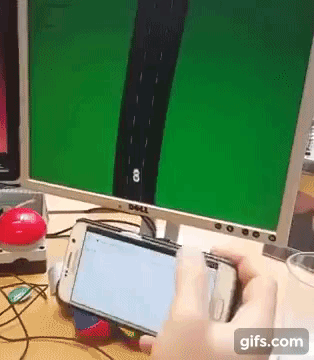As you may know, I’ve lately found an excuse to play with some new web technologies, and I’ve also taken the opportunity to try to gain a deeper understanding of some less bleeding-edge technologies that I think have some interesting potential. And so it was that, while I was staffing the Three Rings stall at last week’s NCVO conference, I made use of the time that the conference delegates were all off listening to a presentation to throw together a tech demo I call Steer!

As you can see from the GIF above, Steer! is a driving game. The track and your car are displayed in a web browser on a large screen, for example a desktop or laptop computer, television, or tablet, and your mobile phone is used to steer the car by tilting it to swerve around a gradually-narrowing weaving road. It’s pretty fun, but what really makes it interesting to me is the combination of moderately-new technologies I’ve woven together to make it possible, specifically:
- The Device Orientation API, which enables a web application to detect the angle at which you’re holding your mobile phone
- Websockets as a mechanism to send that data in near-real-time from the phone to the browser, via a web server: for the fastest, laziest possible development, I used Firebase for this, but I’m aware that I could probably get better performance by running a local server on the LAN shared by both devices
- The Canvas API to draw the output to the screen

The desktop browser does all of the real work: it takes the orientation of the device and uses that, and the car’s current speed, to determine how it’s position changes over the time
that’s elapsed since the screen was last refreshed: we’re aiming for 60 frames a second, of course, but we don’t want the car to travel slower when the game is played on a
slower computer, so we use requestAnimationFrame to get the fastest rate possible and calculate the time between renderings to work out how much of a change has
occurred this ‘tick’. We leave the car’s sprite close to the bottom of the screen at all times but change how much it rotates from side to side, and we use it’s rotated to decide how
much of its motion is lateral versus the amount that’s “along the track”. The latter value determines how much track we move down the screen “behind” it.
The track is generated very simply by the addition of three sine waves of different offset and frequency – a form of very basic procedural generation. Despite the predictability of mathematical curves, this results in a moderately organic-feeling road because the player only sees a fraction of the resulting curve at any given time: the illustration below shows how these three curves combine to make the resulting road. The difficulty is ramped up the further the player has travelled by increasing the amplitude of the resulting wave (i.e. making the curves gradually more-agressive) and by making the road itself gradually narrower. The same mathematics are used to determine whether the car is mostly on the tarmac or mostly on the grass and adjust its maximum speed accordingly.

In order to help provide a visual sense of the player’s speed, I added dashed lines down the road (dividing it into three lanes to begin with and two later on) which zip past the car and provide a sense of acceleration, deceleration, overall speed, and the impact of turning ‘sideways’ (which of course reduces the forward momentum to nothing).
This isn’t meant to be a finished game: it’s an experimental prototype to help explore some technologies that I’d not had time to look seriously at before now. However, you’re welcome to take a copy – it’s all open source – and adapt or expand it. Particular ways in which it’d be fun to improve it might include:
- Allowing the player more control, e.g. over their accelerator and brakes
- Adding hazards (trees, lamp posts, and others cars) which must be avoided
- Adding bonuses like speed boosts
- Making it challenging, e.g. giving time limits to get through checkpoints
- Day and night cycles (with headlights!)
- Multiplayer capability, like a real race?
- Smarter handling of multiple simultaneous users: right now they’d share control of the car (which is the major reason I haven’t given you a live online version to play with and you have to download it yourself!), but it’d be better if they could “queue” until it was their turn, or else each play in their own split-screen view or something
- Improving the graphics with textures
- Increasing the entropy of the curves used to generate the road, and perhaps adding pre-scripted scenery or points of interest on a mathematically-different procedural generation algorithm
- Switching to a local LAN websocket server, allowing better performance than the dog-leg via Firebase
- Greater compatibility: I haven’t tried it on an iPhone, but I gather than iOS devices report their orientation differently from Android ones… and I’ve done nothing to try to make Steer! handle more-unusual screen sizes and shapes
- Anything else? (Don’t expect me to have time to enhance it, though: but if you do so, I’d love to hear about it!)